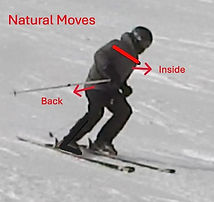SkiMoves.com
See the Difference


See
The difference between Ski Moves
and natural moves
Compare
Your moves and get your score
Improve
With clear goals for how to do it
Golfers have a score - now skiers can too
Before skiing First time Skiers
Do you want a friend or family member to ski?
What run would you start on?
What would you tell them, follow me, turn, make a pizza?
How long will it take, when do you go to harder runs, is it easy?
Would you look for good weather and snow, or go in any conditions?
A different approach Video
More than 80 percent of first timers do not become skiers. Most learn on their own or from family or friends who go to terrain that is too difficult and causes fear, frustration, or accidents. Focus on making Ski Moves before harder runs.
Skiing different than activities like tubing because preparation is necessary for greater success. It is also not like some sports that just need time to figure out because the way we move naturally makes learning more difficult, slows improvement, and reduce safety.
Ski Moves are not natural, they are opposite the way we move naturally, so they take time to develop and maintain. Your ski score gives you a set of steps to focus on rather than just trying to ski harder runs.
Before skiing
Get a great start by practicing Ski Moves before skiing for the first time to know what to do and how to do it.
73 percent skiers ski less than six times a year, it is hard to improve anything with so little practice.
Practice Ski Moves between ski trips for greater success.
Lessons
Private lessons with a good instructor provide guidance and feedback, but they can be expensive and hard to find especially at busy times of the season. Less expensive beginner group lessons can be large and taught by instructors with little experience, so private lessons are more helpful.
Everyone learns in their own way and at their own pace which also makes private lessons better, but it takes more than a one hour lesson. Your progress depends on your age, fitness, ability, knowledge, and amount of quality practice.
A first time skier is not ready to ski the same slopes as experienced skiers after a lesson. Choosing the proper terrain is critical to improving and safe skiing.
If you do it yourself video
You can ski more, watch others, and follow good skiers, but it is easier if you know what moves to make.
Our comparisons help you to see if you are making Ski Moves.
There are more challenges than just skiing harder runs, focus on how you ski not just where you ski.
Get Control
Skiers often like the challenge and freedom of trying to learn on their own.
Natural moves can provide a sense of success, but make it hard to ski slower, make smaller turns, and make parallel turns.
Skiers want better control to ski more difficult runs, but some people don't think they are capable of improving and others think they are so good they don't need to improve. Everyone can improve, even competitive skiers have coaches.
Beyond speed
An emphasis on carving results in many people skiing faster then they can control. There is more to skiing than going fast on steep slopes
Hitting another skier or tree at 30 MPH is like falling off a three story building which causes catastrophic accidents and deaths.
As skiers age they may quit if they feel skiing is too hard on their body because they can not ski slower. Skiing slower with some skidding gives you more control and helps you ski longer
Simple and Consistent
Skiing moves are simple, but that does not mean easy because it is hard to develop Ski Moves that are opposite how we naturally move.
It takes time to replace natural moves with Ski Moves and they are a constant challenge to maintain
Ski Moves are timeless, it is about good execution. A consistent focus is needed. Looking for different ways to say the same thing is helpful, but looking for a new technique makes learning harder.
Precise timing is the formula that describes how to make Ski Moves, it goes beyond a list of fundamentals
About
SkiMoves.com was developed, tested, and refined for more than 20 years using video analysis software with skiers of all levels from beginners to top athletes. We worked with US Ski Team's National Development System, the Professional Ski Instructors of America, National Ski Patrol trainers, the US Special Forces trainers, and training directors from major resorts like Vail to small local resorts. Thanks to all the coaches and instructors we worked with over the years especially Walt Evans, the former director of the National Development System.